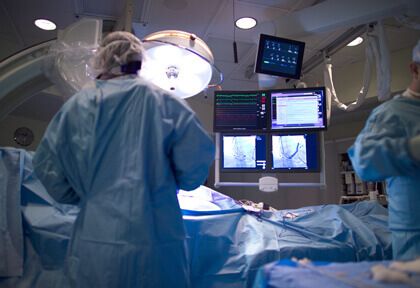The Left main coronary artery supplies circulation to roughly 70% of myocardium, and left main disease requires a high risk intervention with significant impact on patient prognosis. The current guidelines have set the threshold for intervention in LM disease at ≥50% stenosis, irrespective of the presence of symptoms or ischemic burden.

LM calcification is an independent predictor of to all-cause and cardiovascular mortality. Suboptimal preparation and treatment of LM calcified lesions often results in technical failure, with considerably higher risk of major adverse cardiovascular events.
The use of intravascular lithotripsy (IVL) has experienced a steady growth over the years. It delivers controlled sonic pressure waves which selectively fracture calcified plaque within arteries, facilitating effective stent expansion. Though already shown safe and effective for calcification management, there is still little information on IVL assisted left main PCI at short term.
This retrospective multicenter study was carried out in seven centers across the US. It included patients with severe “de novo” left main lesions, both in acute (ACS) and chronic syndromes, assessed with fluoroscopy or intravascular imaging showing ≥270° of calcium on at least 1 cross-section of the target lesion.
Read also: Edge-to-Edge Repair in Cardiogenic Shock
Between January 2019 and January 2023, data from 184 patients undergoing IVL assisted left main PCI were collected. Patients were predominantly ACS cases (65.4%), with severe calcification was present in 90.7% of patients based on angiographic criteria (100% based on IVI criteria); 25.1% presented LM bifurcation lesion.
Prior IVL, predilation was performed in 83.1% of cases and rotational atherectomy in 18.4% of cases. IVL administered mean 70 ± 27 IVL pulses during treatment. After IVL, balloon dilation was performed in 76.7% of cases, with 9.7% using a specialty balloon. Stenting was successful in 99.4% of cases, with a significant increase in minimal lumen area compared with post PCI minimal stent area (4.1 ± 1.3 to 9.3 ± 2.5 mm2, respectively; P <0.001).
As regards adverse events, inhospital major adverse cardiovascular events (MACE) rate was 4.4%, comprised of 3.9% all-cause mortality, 2.2% myocardial infarction and 0.6% coronary perforation and no reflow. 30-day MACE reached 8.8%, with 7.2% all-cause mortality and 3.3% myocardial infarction. After multivariable logistic regression, the presence of acute myocardial infarction was the only significant predictor of 30-day MACE.
Conclusions
To sum up, IVL assisted percutaneous coronary intervention of calcified left main lesions showed high technical success, substantial post PCI lumen area increase and low risk of MACE at short term.

Dr. Omar Tupayachi.
Member of the Editorial Board of SOLACI.org.
Original Title: Retrospective Multicenter Analysis of Intravascular Lithotripsy Use During Calcified Left Main Coronary Artery Percutaneous Coronary Interventions.
Reference: Robert F. Riley, Larry E. Miller, Rhian Davies, Khaldoon Alaswad, Zaid Al-Jebaje, Darshan Doshi, Farouc A. Jaffer, Srikanth Adusumalli, Jarrod D. Frizzell, Kris Kumar, Mitul P. Patel, Ali Dakroub, Ziad A. Ali. Retrospective Multicenter Analysis of Intravascular Lithotripsy Use During Calcified Left Main Coronary Artery Percutaneous Coronary Interventions. Journal of the Society for Cardiovascular Angiography & Interventions, Volume 3, Issue 2, 2024. https://doi.org/10.1016/j.jscai.2023.101213.
Subscribe to our weekly newsletter
Get the latest scientific articles on interventional cardiology





